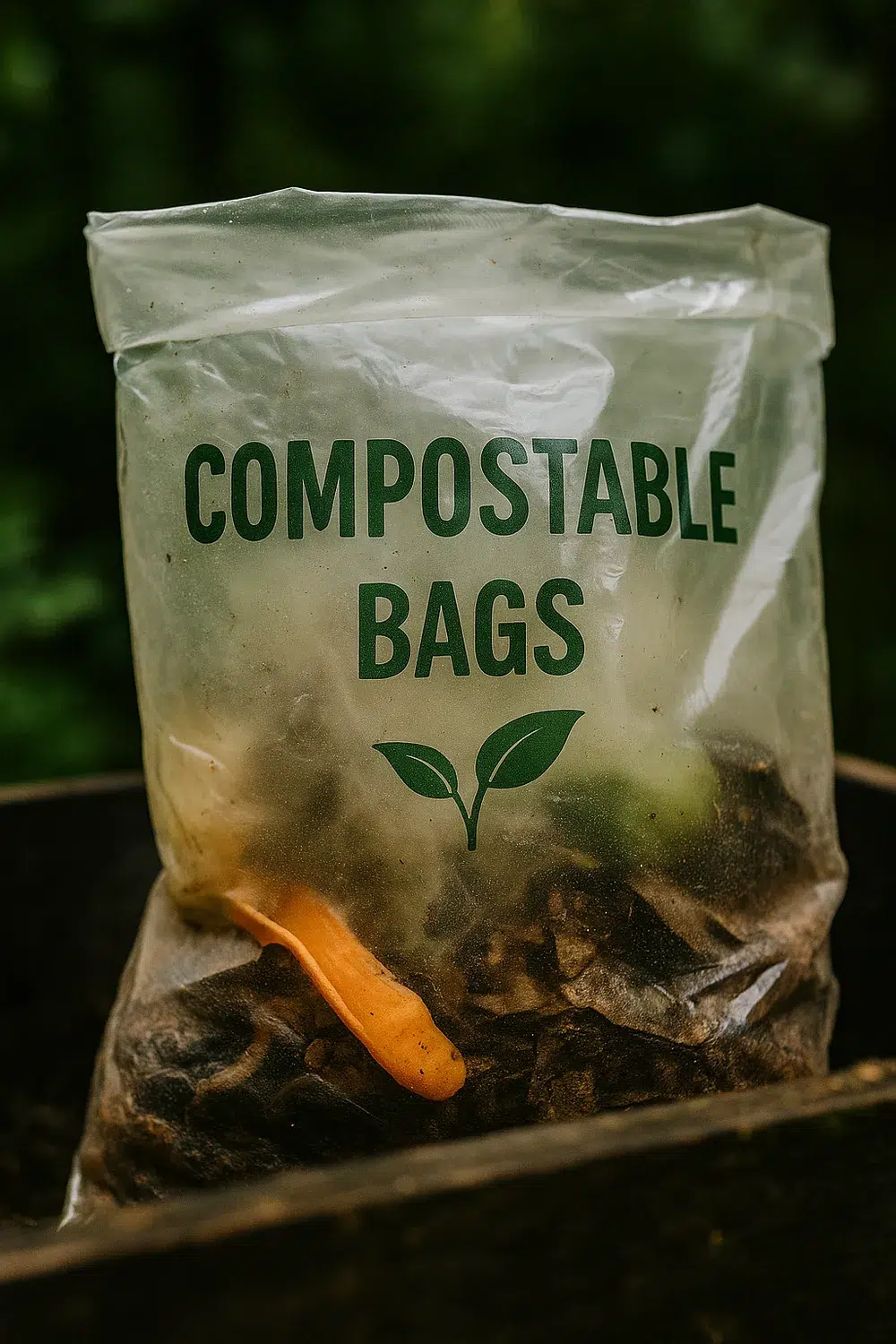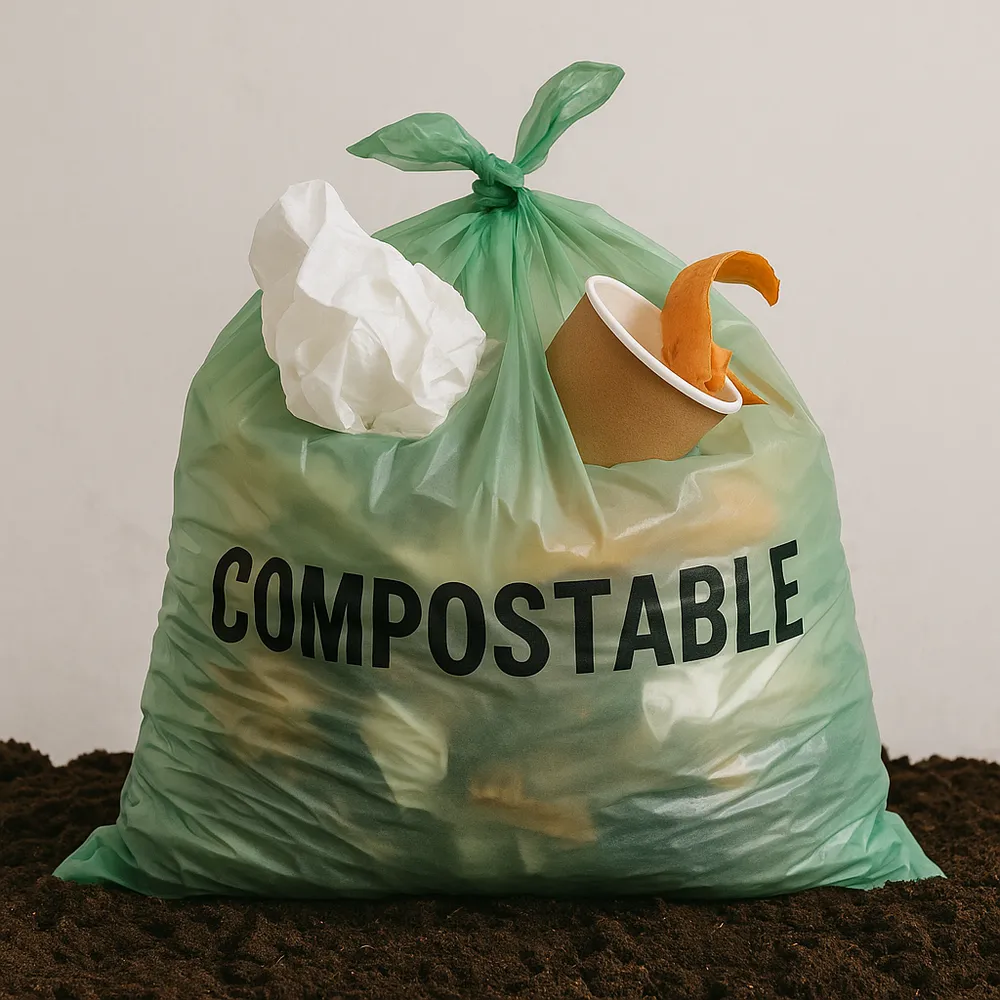Fix Compostable Bags Not Breaking Down: 3 Smart Ways!
We’ve all been there, right? Especially when using shopping bags. You diligently separate your food waste, put it in what you thought was a super-eco-friendly compostable bag, and then… nothing. Months later, you’re staring at a still-intact bag, wondering what went wrong. Turns out, you’re not alone. Let’s dive into why these bags sometimes fail to live up to their promise and what we can do about it.
Table of Contents
The Broken Promise of Compostable Bags
A 2019 study found compostable bags intact after 27 months in soil
Imagine this: you’re doing your part, diligently separating food scraps and organic material for a greener tomorrow, carefully placing it all in a compostable bag. Then, a grim reality check hits. , revealing these supposedly eco-friendly bags can linger for over two years without properly breaking down. This is a serious issue, and a big part of the problem is the gap between the theory of compostable bags and how they actually perform in the real world. This isn’t just a minor inconvenience; it’s a significant failure of the system to address the lack of oxygen in composting environments.
Stats: Only 3% of compostable packaging reaches proper facilities
The truth is, even when we choose compostable bags, they often don’t end up where they need to be. Startlingly, only around 3% of all compostable packaging actually makes it to the compost facilities required for proper breakdown. This statistic highlights a major problem: the lack of adequate infrastructure and public access to commercial composting. Many compostable bags end up in landfills, where the conditions aren’t right for the biodegradation process, rendering them no better than traditional plastic bags. This is a heartbreaking truth for conscientious composters who are trying to do their part for a sustainable future.
Thesis: Systemic gaps between design theory and real-world breakdown
The core issue lies in the systemic gaps between the design theory of compostable bags and the harsh reality of their breakdown in various disposal scenarios. Compostable bags are often designed to decompose under very specific conditions, usually found in industrial composting facilities. However, the reality is that most bags end up in landfills, where they lack the right combination of moisture, temperature, and microbial activity to properly break down. Even home compost bins often don’t reach the thermophilic temperatures needed for many compostable plastics to fully decompose. It’s a disconnect that undermines the whole purpose of using compostable bags in the first place, leading to a crisis of confidence in these eco-products.
Why Compostable Bags Not Breaking Down: Science of Decomposition!

Conditions Required: Heat (50-60°C), moisture, microbial activity
For a compostable bag to truly live up to its name, specific conditions are non-negotiable. Think of it like baking – you can’t get a cake without the right temperature and ingredients. Compostable materials need consistently high heat, ideally between 50-60°C, to kickstart the biodegradation process, ensuring they decompose in less than 180 days.. Moisture is another crucial factor, acting as the catalyst for microbial activity, where microorganisms get to work breaking down the polymer chains of the compostable plastic. Without this trifecta of heat, moisture, and a thriving colony of microbes, your compostable bag might as well be a traditional plastic bag, stubbornly refusing to decompose due to a lack of oxygen.
Material Science: * PLA vs PHA breakdown pathways * Petroleum blends (PBAT) need industrial processing.
The material science behind compostable bags is a fascinating world of polymers and breakdown pathways. PLA (Polylactic Acid) and PHA (Polyhydroxyalkanoates) are two common compostable plastics, but they break down differently. PLA often needs higher temperatures found in commercial composting facilities. Then you have petroleum blends like PBAT (Polybutylene Adipate Terephthalate), which are sometimes added to give compostable bags strength and flexibility. However, these blends often require industrial processing to fully break down and, if not managed correctly, may raise concerns about contamination and even microplastic risk, particularly with bags made from pbat-pla.
Timeline Discrepancies: * 10-45 days in facilities vs. 3+ years in home compost
Here’s where the timeline discrepancies can cause real frustration for conscientious composters. In ideal industrial composting conditions, a certified compostable bag made from pbat-pla should break down in as little as 10-45 days.. However, when you move to the variable conditions of a home compost bin, that timeline can stretch dramatically – sometimes to three years or even longer! This is because home compost bins often don’t reach the consistent thermophilic temperatures required. This extended timeline undermines the idea of a sustainable practice. This failure can lead to people abandoning composting altogether.
5 Root Causes of Breakdown Failure
Landfill Limbo: Anaerobic conditions prevent decomposition.
One of the biggest reasons why your compostable bags might be failing is the final destination: the landfill. Landfills are designed to bury waste, not encourage decomposition. The anaerobic conditions in a landfill completely stifle the biodegradation process. Compostable bags, designed to break down With oxygen and microbial activity, compostable bags are made from materials that can break down in less than 180 days, simply sit there, becoming no better than traditional plastic bags. The entire composting process requires air. So, it’s a failure of the system, not necessarily of the bag itself.
Home Compost Shortfalls: Low Heat and Inconsistent Microbial Activity.
Even when you’re diligently home composting, compostable bags can stubbornly refuse to break down. The issue is often the lack of consistent heat and microbial activity. Home compost bins rarely reach the thermophilic temperatures needed for many compostable plastic formulations to properly decompose. Temperature plays a huge role in break down. Inconsistent moisture levels and a less diverse microbial community compared to commercial composting facilities further contribute to the slow decomposition, leading to frustration for composters.
Infrastructure Gaps: Only 60% of US cities accept compostable bags
A significant bottleneck in the compostable bag story is the lack of widespread infrastructure. The unfortunate reality is that only a portion of cities across the U.S. have the compost facilities and programs necessary to handle compostable packaging effectively. Without access to these specialized biodegradable products institute compost facilities, many shopping bags compostable bags end up in landfills or incinerators, negating their intended benefit. This absence of access is a systemic failure.
Certification Confusion: “BPI Certified” ≠ home compostable
Navigating the world of certification for compostable bags can feel like wading through mud. Just because a bag is “BPI Certified” doesn’t automatically mean it’s home compostable. BPI certification primarily focuses on industrial composting, where higher temperatures and controlled conditions Compostable bags are made from materials that require specific conditions to decompose effectively, ensuring that waste bins are properly utilized. Many bags certified under ASTM D6400 or EN 13432 are designed for shopping bags commercial composting and may not break down effectively in a home compost bin. This confusion regarding recyclable materials contributes to the overall failure of the system.
Greenwashing: “Biodegradable” claims vs microplastic reality
Greenwashing is a major concern, and the term “biodegradable” is often used loosely and can be misleading. While something might technically be biodegradable, it doesn’t necessarily mean it will decompose quickly or completely in a home compost bin or landfill. Some “biodegradable bags” can even fragment into microplastics, posing a potential risk to the environment. This deceptive practice undermines the trust. We need transparency and standards. True sustainable efforts focus on genuine compostable materials like paper bags and composting processes.
User Stories: Real-World Frustrations
Case: Surrey, Canada banning “compostable” bags from the organics program
The city of Surrey, Canada, made headlines when they banned “compostable” bags from their organics program. This decision highlights the real-world frustration with compostable bags that don’t actually break down as expected. The move was driven by concerns about contamination in the compost facilities The ineffectiveness of many current systems highlights the limitation of not incorporating compostable materials into waste management. bags in the composting process. It’s a stark reminder that good intentions don’t always translate into effective sustainable practices. The situation shows the importance of the composting process.
Quote: “Must store bins in garage… only way to control smell” – User complaint
This user complaint perfectly encapsulates the challenges many people face when dealing with food waste and compost bins. The odor issue is a significant deterrent. The need to store bins in the garage, a less-than-ideal condition, shows that there is definitely room for improvement. This highlights a significant problem: poorly functioning composting processes lead to bad odors. This smell is another reason the requirement for proper composting practices cannot be overlooked. practice is bad.
Solutions Framework
Policy Actions:
To really tackle the issue of compostable bags not breaking down, some smart paper bags Effective policy is essential for the prevention of contamination in composting processes and to promote the use of compostable bags. changes are needed. For example, implementing mandatory standards for compostable bags and extended producer responsibility (EPR) schemes are crucial. These schemes make manufacturers responsible for the end-of-life disposal of their packaging, incentivizing them to design truly compostable eco-products. The policy could help the bag industries create better products and avoid greenwashing.
Consumer Steps:
As composters, we have power to affect the composting process! One key step is to verify certification marks and tweak your home composting practices. Be sure to stay within municipal waste collection. The composting process is important for a sustainable environment.
Industry Innovations:
The world of compostable packaging is buzzing with innovation. The use of mycelium to create compostable bags is an exciting development. These mycelium-based bags have shown remarkable results in lab tests, with some achieving 90% decomposition in just 45 days. This kind of rapid break down The requirement for compostable materials holds immense promise for reducing waste and encouraging sustainable practices. plastic waste and creating truly sustainable alternatives to traditional plastic bags. Industry should promote biodegradable and compostable produce bags materials to avoid toxicity. This shows the importance of industrial innovation.
The Future of Compostables
Material advances: PHA from agricultural waste.
The future of compostable materials looks bright, with exciting advances on the horizon. The use of PHA derived from agricultural waste is a promising area. PHA is a type of compostable plastic that offers excellent biodegradability and can be produced from renewable resources. Using agricultural scrap not only reduces our reliance on fossil fuels but also turns a waste stream into a valuable resource. The issue of toxicity is something that industry needs to address with better materials. PHA could be a better solution with less risk.
Infrared sorting tech in composting facilities
To improve the efficiency of composting processes, Compost facilities are beginning to adopt infrared sorting technology to reduce contamination and improve the efficiency of compostable materials in the waste bin.. This technology uses infrared light to identify and separate different types of shopping bags. plastics, including compostable plastic bags. This is important for reducing contamination. Infrared sorting ensures that only truly compostable materials end up in the composting process, leading to higher quality compost and less contamination from non-compostable plastics. The improvement also helps avoid issues with recycling.
Kaleem,
www.greenlifehub.com

